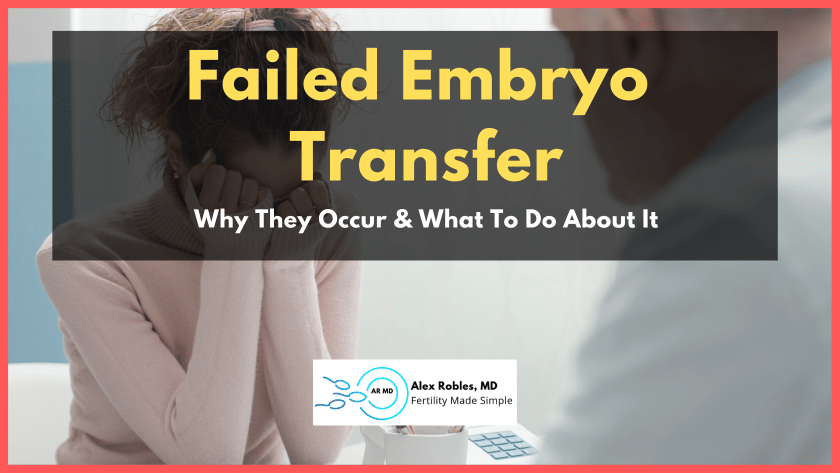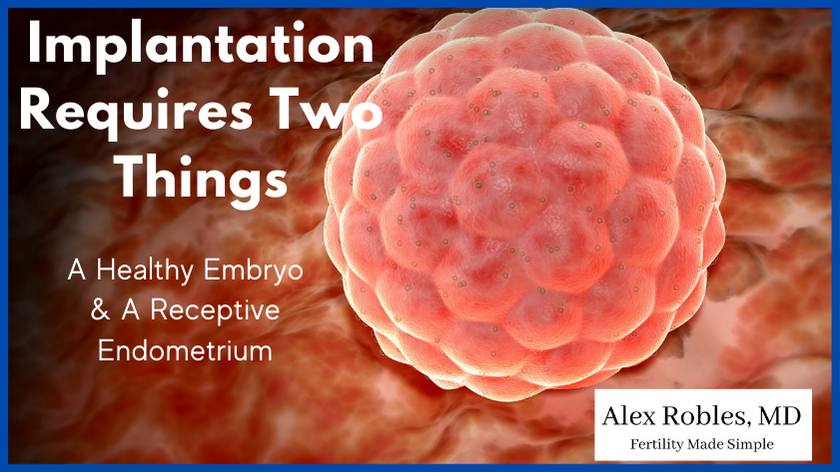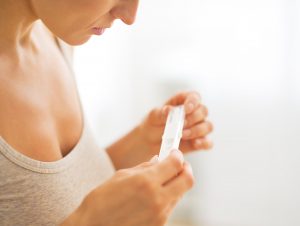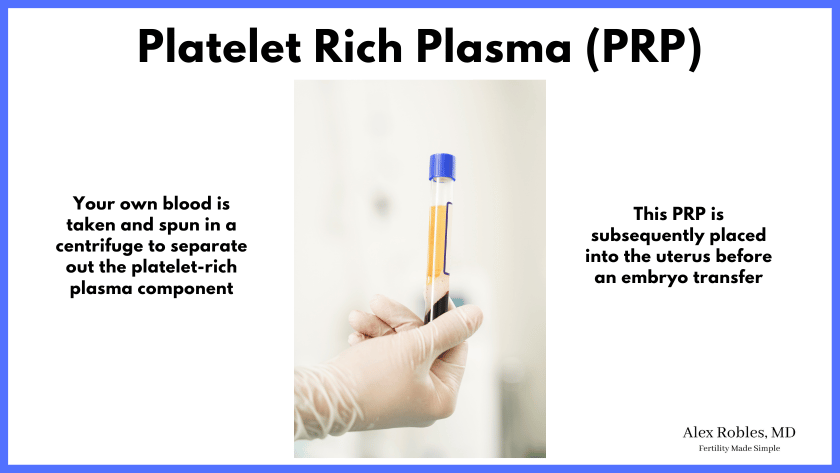A failed embryo transfer can be one of the most devastating events you may experience during the in vitro fertilization (IVF) process.
But why does it happen, and what can you do about it?
Keep reading to learn more.

Why Do Good Embryos Not Implant? Causes of Failed Transfers
Unfortunately, there is no concrete way of knowing why a good embryo fails to implant during IVF. We can test for only a handful of things, and we often don’t find an answer.
With that said, we think about a few things when trying to understand why an embryo fails to implant.
The Quality of The Embryo
Embryo quality is probably the most common reason an embryo transfer does not work. Even if an embryo has a good morphological grade and is chromosomally normal, it does not always implant.
A preimplantation genetic testing (PGT) of an embryo can reveal numerical chromosomal abnormalities, but theoretically, this isn’t the only problem that can exist. Assuming every other variable is normal, there may be other embryo quality issues we cannot yet identify or completely understand.
Moreover, the issue could be with the sperm or the egg that formed that embryo.
Uterine Environment
Another issue that can affect the implantation of a healthy embryo is the condition of your uterus. Factors such as fibroids, polyps, or scar tissue can hinder the embryo’s ability to attach to the uterine wall. However, we usually evaluate the uterus before a transfer to ensure that there are no significant issues.
Secondly, evidence of uterine inflammation (chronic endometritis) may also be associated with implantation failure, but the data is inconsistent.
Lastly, the uterine lining (endometrium) should have a proper thickness and not have fluid in it to maximize the chance of implantation.

Lifestyle Factors
Your lifestyle may also impact the success of embryo transfers. For example, smoking, excessive alcohol consumption, and obesity may decrease your chances of a successful implantation. Healthy lifestyle choices and a balanced diet may increase overall IVF success and pregnancy rates.
Medical Conditions
Lastly, medical conditions like endometriosis and adenomyosis may also reduce your chances of a successful transfer. However, the data is mixed, and it is unclear how much of an effect these conditions have on embryo implantation.
A Quick Word On Endometrial Receptivity
The timing of the embryo transfer is crucial. There is only a short window in which an embryo can attach to the uterine wall, known as the uterine receptivity window.
As such, researchers created a test called the Endometrial Receptivity Assay (ERA) to identify the optimal implantation window. While this test seemed promising at first, a recent large prospective study demonstrated that it isn’t helpful, and in some cases, it may even reduce success rates.
How Common Is Implantation Failure?
At present, successful implantation rates are typically around 60%. However, this rate can vary depending on factors such as embryo morphology, the day on which an embryo reaches the blastocyst stage, and if the embryo possesses the correct number of chromosomes.
- Some studies show that embryos with better morphology are more likely to attach and implant than embryos with poor morphology.
- Studies show that embryos that make it to the blast stage on day 5 and day 6 perform better than those that reach the blastocyst stage on day 7.
- Finally, euploid embryos are more likely to implant than aneuploid embryos (however, this does require preimplantation genetic screening of the embryos).
What Happens If A Transfer Fails? How Do You Diagnose It?
We diagnose a failed embryo transfer by testing for human chorionic gonadotropin (hCG) levels (a pregnancy test) in your blood ~9-12 days after the transfer. A positive hCG blood test indicates that the embryo has implanted.
A negative pregnancy test indicates that the transfer did not work.
If your test is negative, we will instruct you to stop taking your medications which will induce a period.

When Should You Expect A Period?
Your period will usually arrive at the time you would expect it. In other words, it will likely arrive 10-12 days after a blastocyst transfer or 12-15 days after a cleavage embryo (Day 3 embryo) transfer.
If you do not discontinue progesterone supplementation, your period may not start until the medication is stopped.
How Soon Can You Try Again?
Assuming you have more embryos eligible for transfer, it is a good idea to wait for at least one menstrual cycle before trying another transfer.
This short delay will give you time to recover from the process and your doctor time to evaluate possible reasons for the previous failed attempt. Your doctor may want to do additional testing or uterine evaluation before jumping into another transfer.
In the meantime, try not to feel discouraged and remember that many people experience failed transfers before achieving a successful pregnancy. While you wait for your next cycle, focus on maintaining a healthy lifestyle and trying to manage stress as best you can.
Treatment Options For Preventing Embryo Transfer Failure
Further Testing and Evaluation
After the failed transfer, your fertility doctor may recommend further testing to see if an underlying issue needs to be addressed.
Testing could include a hysterosalpingogram (HSG), sonohysterography (aka saline infusion sonogram), hysteroscopy, and an endometrial biopsy. Depending on the results, these tests will delay your next transfer by at least one month.
Unfortunately, many other tests, such as the ERA test, immunologic testing, and other add-ons, are not likely to provide any additional benefit.
Modified Treatment Plans
If you have experienced repeated failed embryo transfers, your reproductive endocrinologist may recommend modifying your treatment protocol. For example, they may recommend adjusting your frozen embryo transfer protocol and trying a medicated vs. a natural vs. a modified natural cycle.
There is no data to say that one is clearly better than the other, but trying a new approach may be beneficial. Sometimes, undergoing a fresh embryo transfer may also be helpful, although this would require another round of IVF.
The data does not support additional treatments like IVIG, Intralipids, or other immunologic treatments at this time.
Trying Again
Sometimes, there is nothing else to check or do, and the best next step is to try another transfer. Data shows that the incidence of recurrent implantation failure is relatively low, and most patients will have a successful pregnancy in subsequent attempts.
With that said, not every patient will have another embryo and may have to undergo ovarian stimulation and egg retrieval again to try and generate more.
Clinical Trial At Columbia University Fertility Center for Failed Embryo Transfers
If you have experienced one failed embryo transfer, you might consider participating in a clinical trial at Columbia University Fertility Center.
We are investigating if placing platelet-rich plasma (PRP) into the uterus before a transfer can improve your chances of a successful pregnancy.
PRP infusion is performed one to three days before the procedure in this trial. This treatment has shown promising results in previous studies of women with recurrent implantation failure.
If you do not meet the study criteria (or if the study has concluded by the time you read this), you can still choose to have PRP performed at our center.

What Is The Likelihood of Success After A Failed Implantation?
When it comes to frozen embryo single-embryo transfer (SET), one big study found that the cumulative sustained implantation rate after up to three consecutive SET procedures is 95.2%.
Individually, the live birth rate was 64.8%, 54.4%, and 54.1% per transfer for the first, second, and third attempts, respectively. These statistics indicate that true recurrent implantation failure rates are relatively low.
Emotional Support and Coping Strategies
Going through a failed embryo transfer can be an emotionally challenging experience. Finding ways to cope and get the emotional support you need during this difficult time is essential.
Surround yourself with people who understand your feelings and can provide comfort and support. Consider joining fertility-support groups or speaking with a mental health therapist specializing in reproductive issues.
Don’t hesitate to consult with your fertility clinic about options for therapy or counseling. Many clinics understand the emotional toll of infertility and can recommend mental health professionals with expertise in IVF-related issues.
Also, practicing self-care and ensuring you’re taking time for yourself is essential. This can include:
- Meditation or mindfulness exercises
- Regular physical activity to help manage stress
- Maintaining a nutritious diet
- Prioritizing sleep and relaxation
Final Words on Implantation Failure
A failed embryo transfer can be an incredibly difficult experience, but it is important to remember that they don’t necessarily mean the end of your fertility journey.
While we don’t always find a cause for why IVF fails, your fertility doctor can work with you to assess possible causes of implantation failure and develop a treatment plan tailored to your specific needs.
Related Articles:
- The Period After A Failed IVF Cycle: What To Expect
- The PGT Embryo Biopsy: What Genetic Defects Does It Screen For?
- Miscarriages After IVF: Why They Occur & What Happens Next
Make An Appointment With Dr. Robles To Discuss Your Fertility Options Today!

Alex Robles, MD
Dr. Alex Robles is a Spanish-speaking Latino-American Reproductive Endocrinologist and Infertility specialist in New York City, and a board-certified OBGYN. He has a special interest in health, lifestyle, & nutrition. Make an appointment with Dr. Robles to discuss your fertility options today!
References:
- Kimura F, Takebayashi A, Ishida M, Nakamura A, Kitazawa J, Morimune A, Hirata K, Takahashi A, Tsuji S, Takashima A, Amano T, Tsuji S, Ono T, Kaku S, Kasahara K, Moritani S, Kushima R, Murakami T. Review: Chronic endometritis and its effect on reproduction. J Obstet Gynaecol Res. 2019 May;45(5):951-960. doi: 10.1111/jog.13937. Epub 2019 Mar 6. PMID: 30843321.
- Liu KE, Hartman M, Hartman A, Luo ZC, Mahutte N. The impact of a thin endometrial lining on fresh and frozen-thaw IVF outcomes: an analysis of over 40 000 embryo transfers. Hum Reprod. 2018 Oct 1;33(10):1883-1888. doi: 10.1093/humrep/dey281. PMID: 30239738; PMCID: PMC6145412.
- Doyle N, Jahandideh S, Hill MJ, Widra EA, Levy M, Devine K. Effect of Timing by Endometrial Receptivity Testing vs Standard Timing of Frozen Embryo Transfer on Live Birth in Patients Undergoing In Vitro Fertilization: A Randomized Clinical Trial. JAMA. 2022 Dec 6;328(21):2117-2125. doi: 10.1001/jama.2022.20438. PMID: 36472596; PMCID: PMC9856480.
- Bakhsh AS, Maleki N, Sadeghi MR, SadeghiTabar A, Tavakoli M, Zafardoust S, Karimi A, Askari S, Jouhari S, Mohammadzadeh A. Effects of Autologous Platelet-Rich Plasma in women with repeated implantation failure undergoing assisted reproduction. JBRA Assist Reprod. 2022 Jan 17;26(1):84-87. doi: 10.5935/1518-0557.20210046. PMID: 34514770; PMCID: PMC8769172.
- Nazari L, Salehpour S, Hosseini MS, Hashemi Moghanjoughi P. The effects of autologous platelet-rich plasma in repeated implantation failure: a randomized controlled trial. Hum Fertil (Camb). 2020 Sep;23(3):209-213. doi: 10.1080/14647273.2019.1569268. Epub 2019 Feb 4. PMID: 30714427.
- Pirtea P, De Ziegler D, Tao X, Sun L, Zhan Y, Ayoubi JM, Seli E, Franasiak JM, Scott RT Jr. Rate of true recurrent implantation failure is low: results of three successive frozen euploid single embryo transfers. Fertil Steril. 2021 Jan;115(1):45-53. doi: 10.1016/j.fertnstert.2020.07.002. Epub 2020 Oct 16. PMID: 33077239.
